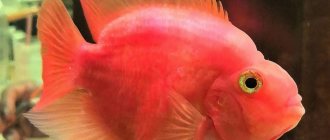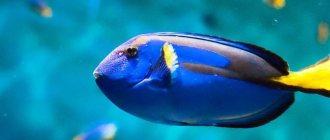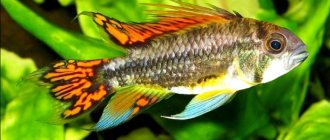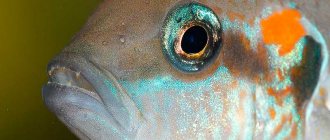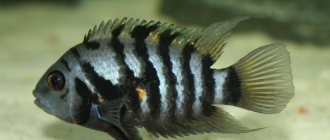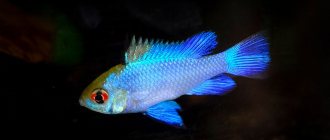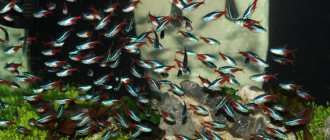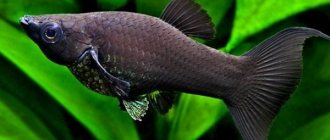Blue Dempsey (lat. Rocio octofasciata cf. English Electric Blue Jack Dempsey cichlid) is considered one of the most beautiful aquarium cichlids. Sexually mature specimens exhibit a bright coloration, until recently one of the brightest blues among aquarium fish. At the same time, they are quite large, up to 20 cm, and are only slightly inferior to their ancestors - the eight-striped cichlids.
Habitat in nature
Cichlazoma eight-striped was first described in 1903. It lives in North and Central America: Mexico, Guatemala, Honduras.
Inhabits lakes, ponds and other bodies of water with weakly flowing or stagnant water, where it lives among snags, with a sandy or muddy bottom. It feeds on worms, larvae, and small fish.
The English name for this cichlid is electric blue Jack Dempsey, the fact is that when it first appeared in hobbyist aquariums, it seemed to everyone to be a very aggressive and active fish, and it was nicknamed after the then popular boxer, Jack Dempsey.
Blue Dempsey cichlid is a color morph of the eight-banded cichlid, brightly colored fry slipped among the juveniles, but were usually discarded.
Actually, it is not known for certain whether they appeared as a result of natural selection or hybrids with another species of cichlids. Judging by the intensity of the color and slightly smaller size, this is a hybrid.
Despite the fact that breeding Blue Dempsey cichlids is quite simple, you can rarely find them on sale, since the fish is not for everyone.
Breeding
Reproduction in a community aquarium
A community aquarium is not the best place for breeding cichlases. Parents furiously clean out the clutch and can cause fatal injuries to fish that swim into the couple’s territory. Perhaps, if you live in a very large aquarium - 1000 liters - representatives of different species will not intersect, but it is not worth risking the health and life of your pets.
In addition, very often other large Cichlids eat the grown cubs of eight-striped individuals. Therefore, it is better to prepare a separate tank.
In the spawning area
Future parents need to be placed in a separate aquarium, which should be at least two hundred liters, because the couple will take care of their babies for a very long time.
The following conditions must be created in the spawning tank:
- water temperature – 29-30 °C;
- high-quality aeration;
- water change every 3-4 days;
- acidity – 6.7-7 pH;
- hardness – 8-12 dH.
It is advisable to place several shelters and snags in the spawning area to create comfortable conditions for parents and future offspring. Be sure to pour 5-7 centimeters of sand on the bottom, because very often cichlids spawn in dug holes.
Spawning
Shortly before the start of spawning, the males have a noticeable copulatory organ from which milk is secreted. The ovipositor of females increases in size and takes on the shape of a cone. During the period of sexual activity, the color of the fish becomes the brightest. Spawning does not last long, during which time the pair manages to lay from eight hundred to two thousand eggs. Most often, several clutches are securely hidden: in dug holes, among decorations, on snags or in thickets of vegetation.
Representatives of this species are caring parents who fiercely protect the eggs. In order not to irritate the fish, it is better to exclude possible stress factors - loud sounds, shocks of the aquarium and sudden flash-like changes in lighting.
Problem with raising fry
Breeding is relatively simple, but the electric blue morph suffers from diseases more than its counterparts. All fry hatch brown-gray, and bright colors begin to appear in carriers of this gene only in the fifth week of life.
For more than twenty days, parents nurse their offspring, do not sail far and closely monitor their numerous babies. When the fry grow up, the parents need to be returned to the community aquarium. After this, in the tank where the young live, the water temperature must be increased to 31-32 °C to reduce the risk of disease. After the fish reach 6-7 weeks of age, the water temperature can be gradually reduced.
In the first weeks of life, cichlases should be fed with “live dust”, Artemia nauplii, and special food for fry. From the age of two months, individuals can already be transferred to “adult” food, but it is advisable to crush it so that the fish do not choke on large pieces of granules or pellets.
Description
Like the regular eight-band, the electrician has a stocky and compact body. They are slightly smaller in size, growing up to 20 cm in length, while ordinary ones are up to 25 cm. Life expectancy is 10-15 years.
The difference between these fish is the intensity and color of the color. While the eight-banded cichlid is more greenish, the Blue Dempsey is bright blue. Males develop long dorsal and anal fins and round black spots along the body.
The fact that the fry are completely dull, light brown in color with light splashes of blue or turquoise does not add to their popularity.
Color develops with age, especially strong and bright color during spawning.
Nutrition
Predatory cichlazomas in nature feed on living organisms. In aquariums they are omnivores and require a balanced diet. They eat equally well live and frozen protein food:
- large bloodworm;
- insect larvae;
- tubifex;
- Artemia;
- worms;
- shellless shrimp and other crustaceans;
- fry, small fish.
When choosing dry food, preference should be given to mixtures enriched with plant additives.
It is not recommended to feed fish with lean meat, squid, chicken, beef heart and other “delicacies”.
The metabolism and digestive system of fish is not adapted to the processing and assimilation of proteins from warm-blooded animals. Such a diet quickly leads to obesity, liver and circulatory system diseases.
Keeping in an aquarium
This is a fairly large fish and for comfortable keeping you need an aquarium of at least 200 liters, if in addition to them there are more fish, then the volume needs to be increased.
Moderate flow and powerful filtration will be useful. It is advisable to use an external filter, as fish create a fair amount of waste that turns into ammonia and nitrates.
Blue Dempsey cichlid can live in a wide range of conditions, but it is believed that the warmer the water, the more aggressive it is. Most aquarists try to keep it in water temperatures below 26°C to reduce aggressiveness.
The bottom is better sandy, as they dig in it with pleasure, with a lot of snags, pots, and shelters. Plants are not needed at all or unpretentious and hard-leaved - Anubias, Echinodorus. But it is better to plant them in pots.
- minimum aquarium volume - 150 liters
- water temperature 24 - 30.0° C
- ph: 6.5-7.0
- hardness 8 – 12 dGH
Diseases and their treatment
Blue suffer from diseases typical of all fish. Very often, deterioration of the condition is observed due to poisoning with nitrogenous substances - nitrites, nitrates and ammonia. In this case, you need to very carefully monitor the water quality in the aquarium.
The most common diseases are:
- Ichthyophriasis. It appears as dense white bumps on the skin. Without proper treatment, the disease is fatal. It needs to be treated at the very beginning of its development. It is recommended to increase the water temperature by 2-3 °C, add malachite greens and iodine solution in the dosage prescribed by the veterinarian.
- Bug-eyed. This disease is characterized by destructive changes in the eyeball, which can sometimes even fall out of the sockets. After this, the blinded fish dies in agony. The disease can be caused by many pathogens, but the main cause is poor water quality in the aquarium. The disease is very difficult to treat and will require the help of a veterinarian.
- Amoebiasis. Caused by parasitism of amoebas in the gills and skin. The fish breathes rapidly and refuses to eat, sometimes becoming very aggressive. As a treatment, you need to place the fish in baths with tinidazole. The procedure must be carried out within four hours.
- Fish tuberculosis. The most dangerous and insidious disease. All infected people must be killed immediately; there are no methods of treatment. Symptoms vary greatly from individual to individual, but the most common symptoms include swollen eyes, a swollen abdomen, and ruffled scales called “fir cones.”
Good nutrition and proper care of your pet play a very important role in preventing diseases.
Compatibility
Although eight-lined cichlids are very aggressive and not suitable for a community aquarium, Electric Blue Jack Dempsey are calmer.
Their aggressiveness increases with age, and like all cichlids during spawning. If fights with neighbors are constant, then most likely the aquarium is too small for them and the pair needs to be transplanted into a separate one.
These fish are clearly incompatible with all smaller fish (characins and small carps such as neon), relatively compatible with cichlids of equal size and well compatible with large fish (giant gourami, Indian knife, pangasius) and catfish (black bargus, plecostomus, pterus ).
Behavior and character
There is an opinion among aquarists that the Blue Dempsey is an incredibly smart fish, quickly remembers its owner, understands his speech and is even capable of following commands. Whether this is true or fiction, no one has reliably verified it. However, scientists and experienced aquarists know another interesting fact: fish radically change their behavior patterns with age.
The fry develop much more slowly than their wild ancestors, the eight-striped cichlases, and are characterized by poor health. Perhaps this is why blue dempsey fry are very timid and prone to stress. In some cases, they even have to be kept separately from their peers.
With age, the character of the fish changes beyond recognition. Males and even females become more and more confident and aggressive until they decide to take over the aquarium. The intense habits of the predator reach their peak in adulthood, so the cichlid will attack small fish and eat them with pleasure.
It is recommended to keep pets in pairs. Adults do not like their relatives and are reluctant neighbors. What is typical: fish choose a mate at an early age, long before the onset of puberty, and remain faithful to their partner all their lives.
Compatibility with other types
This blue cichlid is not considered the best neighbor. Very often a large and fearless pair of blue electrics will crowd out other fish. This subspecies tolerates living in the same aquarium relatively well with other large cichlids, including the ancestors and founders of the selection form.
Other good neighbors are large and bold fish:
- black bargus;
- giant gourami;
- discus;
- knife fish;
- plecostomus;
- brocade pteroplychth.
Relatively compatible species are considered to be cichlids of the same size or slightly smaller. A more peaceful atmosphere will appear when the eight-banded, Managuan and diamond species are introduced.
Any small and harmless fish will be eaten.
Incompatible species are:
- guppy;
- angelfish;
- swordtails;
- barbs;
- neons;
- all veiled;
- arthropods - crabs and shrimp.
At the same time, predatory school piranhas will not mind feasting on Blue Dempsey.
How to determine the variety “species” of Blue Dream shrimp?
Blue dream shrimp species
There are no clear definitions. To begin with, there is currently no clear agreement on the classification of blue dream shrimp. The article discusses several of the most popular varieties.
Opacity and even color define the variety. The highest grade blue dream shrimp should have a deep, blue color throughout. Even on the tips of his legs there are no translucent spots visible. A black head color is generally considered less desirable than even a blue color without hints of black.
Blue dream shrimp photo
Some Blue Dream shrimp may look like they are rusty on top. Moreover, this is typical for all classes, and most shrimp breeders believe that this does not affect the class rating.
Shades may vary. Some Blue Dream shrimp are purple in color, some are almost black, and some are much lighter in color.
Personal preference always matters a lot. If you intend to breed blue dream shrimp for sale, you will always strive to produce specimens that fall into the higher grades. After all, they are considered better quality and cost more. Are they better? It is not always so. "Low grade" shrimp are just as healthy, and sometimes even healthier (due to lower levels of inbreeding), than high grade shrimp. In the end, the most important factor is what you think is best!
Reviews
The owners of the fish emphasize the aggressiveness of the pet, low immunity, but also call cichlasoma the most beautiful and easy to care for and feed.

